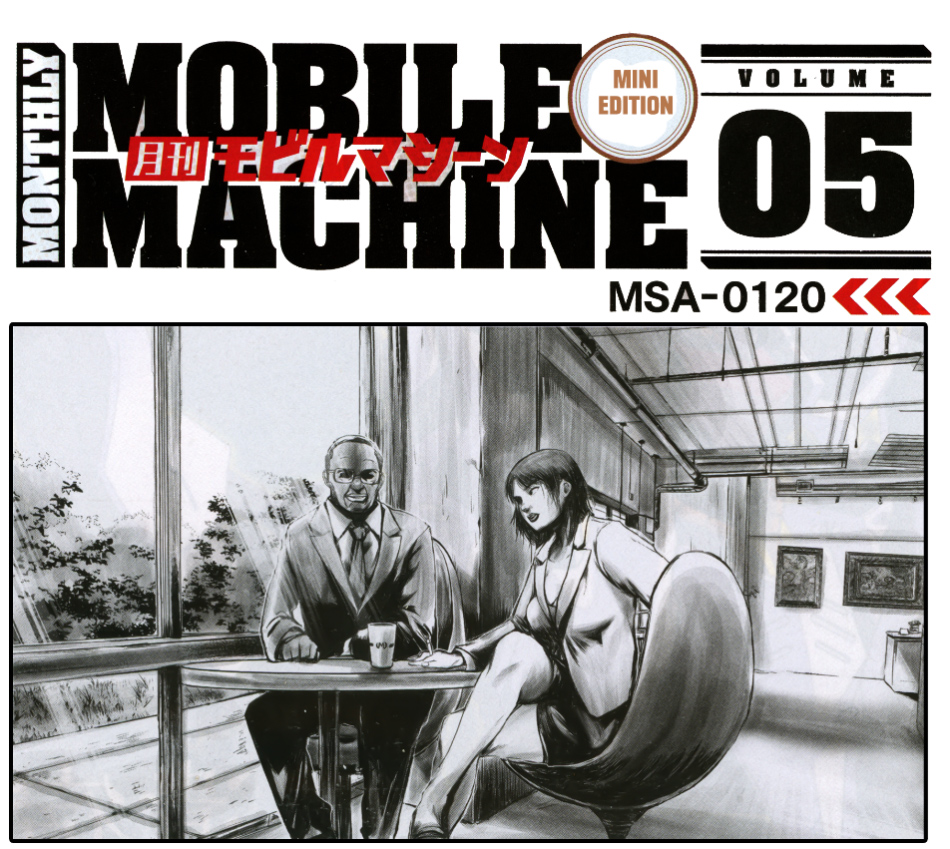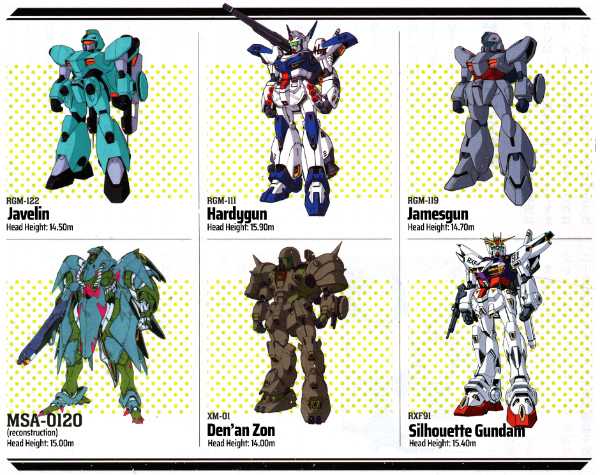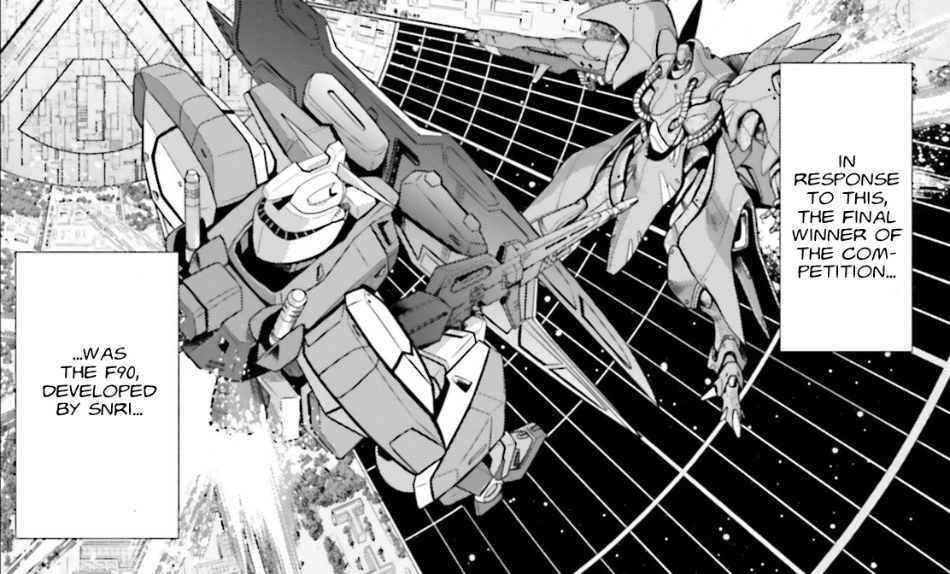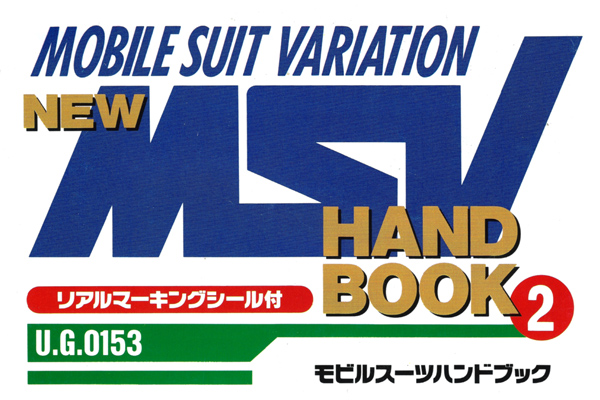MONTHLY MOBILE VOL.05
Dinah: Professor Krefeld, good morning to you. It’s been a while since we last spoke, but I’m sure you remember me – Dinah Kim Ginzaeva.
Krefeld: Dinah, my dear, it has been a while! Oh, I see you’re married now.
Dinah: Yes. Last month, actually, to Ensign Ginzaev of the Ameria Defence Forces.
Krefeld: Well congratulations. I’m sure he’s a fine soldier. So let’s get down to business, shall we? You wanted to ask about the MSA-0120, was it?
Dinah: Yes, I was hoping you could tell me a bit more about that mysterious mobile suit.
HISTORY OF MOBILE SUIT MINIATURIZATION
Dinah: For starters, I wanted to ask you about the ATMS Project. I’ve mentioned it in previous articles in our series, but I’d appreciate you sharing your current thoughts on it.
Krefeld: The development project for the Federation Forces’ next mainstay mobile suit, the Advance Tactical Mobile Suit (ATMS), began with SNRI’s proposal to the Federation government in U.C.0102 to miniaturize mobile suits. At the time, the FD-03 Gustav Karl, which was under consideration as the next mainstay suit, had a head height of 22 meters, similar to the Nu Gundam. So, it was almost inevitable that if all the military’s requirements were taken into account, it was highly likely that the next mainstay mobile suit would be in the 30-meter class, on par with the MRX-011 Mass Production type Psycho Gundam and the later RX-104FF Penelope.
Dinah: So then, why did SNRI submit the plan to the Federation government and not the military?
Krefeld: SNRI is currently divided, so the lunar-based branch is often misunderstood because it behaves like a corporate entity. However, at the time, they were a research and development organization with close ties to the Colony Public Corporation. Following their reorganization in 0093, they began developing mobile suits, but they had strong characteristics as a neutral observer. This is also part of the reason why they maintained a sort of non-intervention during the Gryps War or accepted asylum-seeking engineers from the Titans and Axis.
Dinah: As you mentioned, the Earth Sphere is more or less medievalized these days, and it’s becoming more common for personnel to move between different forces.
Krefeld: Precisely. Across human history, the time when yesterday’s enemies are today’s friends is longer. SNRI served as an asylum for engineers and political thinkers, so that’s why it was able to confront the Federation government from a neutral standpoint: the exponential increase in mobile suit size would lead to an inexhaustible rise in the cost of maintaining military facilities.
Dinah: Almost all military installations across the Earth Sphere are presumed to have head heights of around 20 meters for mobile suits. So if the 30-meter class were to become the new mainstay, all the facilities would have to undergo radical upgrades, and estimates show that would put an unbearable burden on the Federation government, wouldn’t you say?
Krefeld: You would be correct. As I’ve already said, even the Jegan, with its head height in the 20-meter class, would be difficult to operate on a modified Salamis-class. Basically, SNRI’s plan to downsize mobile suits without updating current facilities and to move forward with colony development with fewer budgetary demands from the military was quite appealing to the Federation government, even if this was at the behest of the Colony Public Corporation.
Dinah: All while the elite reimmigrated to Earth, am I right?
Krefeld: (chuckles) You could say that. It’s also in their nature to budget for something like that. After the end of Char’s Rebellion and the opening of Laplace’s Box, military service became little more than glorified relief work for the unemployed, so the authority of broader police forces like MHA saw expansion.
Dinah: And that also sort of primed the pump for Mafty Erin… So, Anaheim proposed the RGM-109 Heavygun?
Krefeld: I would have to say people’s understanding of that isn’t quite right. Between 0102 and 0109, there were various approaches among companies when it came to making prototypes of miniaturized mobile suits. Many were merely scaled-up versions of middle mobile suits, like the F50D, or known units like the Guntank R-44. Whether it’s the Draken that was developed by Side 6 back in the day, the AMX-102 ZSSA that reduced its basic structure head height to 15 meters, or the D-50C Loto developed for troop transport, the notion of escaping from a dinosaur evolution by miniaturizing mobile suits was pretty common among engineers. The RGM-109 was a culmination of that trial and error process, and over the next seven years, they succeeded in scaling back the performance of current mainstay mobile suits to the 15-meter class.
Dinah: But it’s been reported that SNRI wasn’t satisfied with the performance of the RGM-109.
Krefeld: Correct, and that also goes for out in the field. The RGM-109 was by no means a poor mobile suit, but in operation, it was perceived as an updated version of the RGM-89J. But you could also say this was factored in. So the 109 was really just a stopgap, and the updated version, the RGM-111, was considered the front-runner. Essentially, the RGM-89 and FD-03 would be replaced by the RGM-111, and the project was supposed to be sunset.
LAUNCH OF THE ATMS PROJECT
Dinah: In U.C.0110, the Federation government put a stop to the RGM-111 procurement program and green-lit the ATMS project. This is attributed to Assemblyman Hauzerie Ronah, but did he have that much sway?
Krefeld: That’s how he presented it to his constituencies, but it’s hard to imagine that he had that much political power, having only just taken over his uncle Engeist’s electoral power base. I should think that the Ronah family, and by extension, the Colony Public Corporation, played a larger role.
Dinah: Would you say that marks a step towards independence for Cosmo Babylonia?
Krefeld: There was likely that too, but more so, the Assembly at the time tended to have an aversion towards Anaheim’s influence. Now, while I don’t mean to give any credence to the underground conspiracy theories about Laplace’s Box and all, there’s no denying that many assemblymen hated feeling the “yoke of Granada” that had been around them since the Gryps War. Just as we, the citizens of Ameria, do.Dinah: So what you’re saying is that those who were wary of Anaheim’s unilateral dominance tried to avoid awarding development of the next-generation mainstay mobile suits to a private corporation?
Krefeld: That’s correct. SNRI and the Colony Public Corporation were afraid that Anaheim’s vested interests would hold back colony development, even if it was to add more cushy positions for the corporation’s people.
Dinah: But the ATMS project, whose entire goal was to develop mainstay mobile suits at SNRI and Federation arsenals, was leaked to Anaheim, causing a torrent of stern protests on Anaheim’s part.
Krefeld: You’re absolutely correct. Anaheim’s economic scale is on par with the entire North American continent from the old century. While revenue from the military sector amounts to a fraction in Anaheim’s eyes, that doesn’t necessarily mean it’s something to be taken lightly, as it far exceeds even that of a small colony state. Besides, I don’t think I need to mention that maintaining control over the hub of military technology goes hand in hand with guaranteeing security on the moon.
Dinah: I see. So that brings us to the competition at the end of U.C.0111.
MSA-0120
Krefeld: Initially, it was believed that Anaheim would only participate in the competition with the RGM-111X. But that itself isn’t the strange part. So long as there are no external threats, it was considered to have secured just the right performance if it could exceed the RGM-109.
Dinah: Be that as it may, the fact that data was leaked on the Den’an Zon that Buffo was developing at the time forced both SNRI and Anaheim to make significant changes to their projects.
Krefeld: The Den’an Zon followed the design of the RGM-109, which included a large generator in the backpack and high-output thrusters mounted across the body, bringing it all together at a higher level. While that was the plan on paper at the time, it was evident that if an anti-Earth Federation government organization acquired a mobile suit of this particular class, then they wouldn’t be able to respond with the RGM-111X.
Dinah: In fact, both Mars and Jupiter later developed mobile suits that rivaled or outright surpassed Anaheim, isn’t that right?
Krefeld: Since mobile suits are space machines, after all, it’s inevitable that their technology would be leaked. This is particularly true in today’s society, where having a military division is seen as a prerequisite for top-tier companies.
Dinah: So, as a result, one of the unspoken items would be shared between “procuring a simple 15-meter class mobile suit that maintains the same performance as fifth-generation suits” and a “generator output over 3,000kW.”
Krefeld: And with that, the MSA-0120 finally makes its debut.
X X X
Dinah: First of all, is this strange appearance really an accurate reconstruction?
Krefeld: I can assure you it’s accurate. The Zeonic division at the Granada headquarters was in charge of its development. From their point of view, their pride in having developed the Zaku, which is in the vein of none other than their own company, then the RGM-109, which faithfully adheres to the Tem Ray design, may have been seen as a regression… I say that in jest, of course. In reality, this likely means that in the process of downsizing the RX-104FF design, an armor shape was chosen that emphasized aerodynamic performance and sloped armor for ballistic resistance. The larger skirt and backpack are a Minovsky flight and integrated sturm thruster unit.
Dinah: So then why not make the head unit a so-called Gundam type? Did they feel they wouldn’t win?
Krefeld: Political reasons were likely the main reason for that. With the success of efforts like the AEUG and the Mafty uprising, the perception of the Gundam as a symbol of the anti-establishment had spread to the masses. I think that wouldn’t be seen as a positive factor when it came to adoption. In fact, there’s even a theory that among the in-house plans was an RGM-111-based Gundam type submitted by the Von Braun branch. This suit was later considered the design base for the RXF91.
Dinah: So, as a result, a wide-angle, non-moveable mono-eye, much like the MSA-099 Rick Dias, was adopted. There are also talks of gravity weapons being used as armaments.
Krefeld: Pure sci-fi exaggeration. I mean, think about it. For a mobile suit to use a black hole as a weapon, it would have to be equipped with a micro black hole degenerative reactor at the very least. I don’t think we could call it a mobile suit at that point (laughs). Although maybe even in those times, the most powerful mobile suits would be called a Gundam, though.
Dinah: It’s hard to imagine that mankind would still be at war even if they managed to control gravity (laughs). In one of your papers, you hypothesize that it’s a gravity railgun with a Minovsky Drive.
Krefeld: The Minovsky acceleration weapon, known as the high-impact gun, was expected to have more destructive power than conventional rail cannons, which accelerate projectiles with Lorentz force and minimize collateral damage to a colony by controlling projectile speed. In truth, there was considerable difficulty in supplying power from the mobile suits and with Minovsky control–this was another Anaheim thing. I haven’t found any other examples of it being adopted outside the MSA-0120, though that’s likely to change with future revelations.
Dinah: Its overall weight reached 54.8 tons. What is the intention behind that?
Krefeld: Ah ha, a question for your readers, I see (laughs). It’s just like the F90 A-Type. It can carry 30 tons of propellant for long-range incursions, assuming Minovsky Flight is used. We see the same with the F90 A-Type. While the F90 tried drawing on the RX-78 in terms of versatility through added options, the MSA-0120 attempted to satisfy the requirements by rounding out the full range of performance from inside the suit. Unique tech such as the “mega boost,” which increases the output of the fusion reactor via energy CAP, and the evaporative applique armor, a composite anti-beam material that utilizes new materials, can be said to be a solid design, typical of Anaheim’s pursuit of high performance in a stand-alone mobile suit.
COMPETITION DEFEAT AND THE AFTERMATH
Dinah: In the ATMS competition, while it was judged to be superior in terms of maximum output and ballistic resistance, it was outdone by the F90 in terms of operating costs and mobility.
Krefeld: That’s the moment a resounding no was given to the lineage of Anaheim Gundam’s, which was high performance but at a high cost. This alone could have been reversed, but the fact that Anaheim suffered total defeat to the F90 in the competition was a result that not even Anaheim had control over.
Dinah: Most of the data from this competition is still not available to the public, which is partly due to the involvement of the Jupiter Fleet. However, the facts seem to indicate that the F91 required the same maximum output and ballistic resistance levels as the MSA-0120.
Krefeld: In any event, the stage was once again set for a political struggle, with the arsenal faction pushing aside the Anaheim faction and ultimately resulting in Anaheim continuing to receive orders for the production of the mainstay suits to be developed later.
Dinah: There’s also talk that additional MSA-0120s were later produced and utilized in combat for the Silhouette Formula project.
Krefeld: Nothing more than an urban legend, my dear.  Anaheim had no reason whatsoever to cross such a dangerous bridge at the time. Truth be told, it was likely still in the research and development phase at Granada and was one of the design bases for the RXF91 and RGM-122 Javelin. Even if it had been fielded, it certainly would have been modified, so it’s reasonable to consider it a different mobile suit from the one used during the competition.
Anaheim had no reason whatsoever to cross such a dangerous bridge at the time. Truth be told, it was likely still in the research and development phase at Granada and was one of the design bases for the RXF91 and RGM-122 Javelin. Even if it had been fielded, it certainly would have been modified, so it’s reasonable to consider it a different mobile suit from the one used during the competition.
Dinah: Thank you so very much for your time today. Next time, I’d like to discuss Jupiter SNRI and the F9 development project with you.
Krefeld: Oh, of course. I’ll put together some materials for you. There are also some rather interesting reports about the Gatie party. Do give my regards to Ensign Ginzaev for me. The future of Ameria will be built by young people like you all.
(U.C.0146.10.30
Dina Kim Ginzaevas)
From the Editor’s Office
Professor Martin Krefeld died in a fire at his home on November 2nd. Our deepest sympathy goes out to his family in their time of need.








